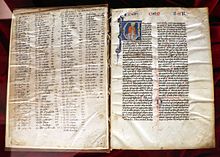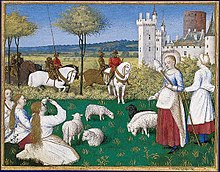Legenda aurea


The Legenda aurea ( legénda aúrea ; Latin for 'golden legend') is a collection of originally 182 treatises on church festivals and above all, written in Latin by the Dominican Jacobus de Voragine (1228 / 29–1298), probably around 1264 Life stories of saints and legends of saints . Jacobus, who was Archbishop of Genoa from 1292 until his death in 1298 , created the best-known and most widely distributed religious folk book of the Middle Ages .
plant
Jacobus de Voragine arranged his work according to the course of the church year . He devoted his own detailed depictions to the major festivals ( Christmas , Epiphany , Easter , Ascension Day and Pentecost ) and explained the importance of the times , the liturgy and customs . This book could serve as a guide for reflection on festive days as well as a daily edifying reading.
The epoch-making novelty of this book was felt from the beginning; As Nova legenda or Novum passionale , it began a unique triumphal march through the whole of the West immediately after its publication . There is evidence of a manuscript in Germany as early as 1282; around 1470 the Legenda aurea was also printed. Jacobus' collection has been translated into many languages and often expanded to include local legends, almost doubling its original size. The miracles, sufferings and adventures of the saints of the liturgical year, compiled from many sources, were presented in a generally understandable manner and had a great influence on art and popular piety.
The work also had consequences due to the novelty of its style, which was characterized by the condensed brevity of the presentation and the simplicity of the language. This style of language became so authoritative that it was later often taken for granted as the legendary style.
Historical criticism
Jacobus has gathered a wealth of material for his collection. In many places in his work he mentions his sources, for example the church fathers Augustine and Jerome and others. Sometimes different versions of the same event are communicated; sometimes the author also indicates that he does not consider his sources to be credible. He also tries to clear up inconsistencies and contradictions, or express doubts about the truth of his own account.
reception
The legends of Jacobus were next to the martyrologies for many centuries one of the most important sources of the veneration of saints ; Prayers and whole forms of devotion go back to them. The saints' attributes, which are important for iconography , are primarily derived from the Legenda aurea ; numerous individual motifs as well as many subjects of the fine arts cannot be understood without this work.
Text editions and translations
- Jacobus a Voragine: Legenda aurea, vulgo Historia Lombardica dicta. Recensuit Theodor Graesse . Dresden / Leipzig 1846; 2nd edition Leipzig 1850; 3rd edition Breslau 1890; Reprint Osnabrück 1969. (Digital copies: 1st edition MDZ , 2nd edition archive.org , 3rd edition archive.org )
- Jacobus de Voragine - Legenda aurea . German by Richard Benz , published by Eugen Diederichs in Jena, popular edition 1925, first volume, 1.078 Gr. heavy, printed in the E. Haberland Offizin in Leipzig, printing arrangement, initials, title and binding by Richard Benz.
- The Legenda Aurea of Jacobus de Voragine , from the Lat. trans. by Richard Benz. 14th edition. Gütersloher Verlagshaus, Gütersloh, 2004, ISBN 3-579-02560-0 (new sentence, text is no longer in Fraktur!)
- Jacobus de Voragine: Legenda Aurea . Latin-German. Edited and translated by Rainer Nickel. Philipp Reclam jun., Stuttgart 1988, ISBN 3-15-008464-4 (short selection: 24 legends)
- Jacobus a Voragine: Legenda sanctorum et martyrum - legends of saints and martyrs . Selection, translation and comments by Alexander Fest (= dtv bilingual - Edition Langewiesche-Brandt ). dtv, Munich 1988, ISBN 3-423-09251-3 (short selection: 11 legends).
- Jacobus de Voragine: Legenda Aurea - The legends of the saints of the Middle Ages , ed., From the Lat. trans. and with various attachments by Matthias Hackemann, Cologne 2008, ISBN 3-86647-284-6 .
- Iacopo da Varazze: Legenda aurea , ed. by Giovanni Paolo Maggioni, Florence 1998.
- Jacobus de Voragine: Legenda Aurea - Golden Legend , Latin-German, translated by Bruno W. Häuptli . Herder Verlag, Freiburg im Breisgau 2014, ISBN 978-3-451-31222-9
- Jacobus de Voragine: Legenda aurea (rhfrk.) - MS-C-120 . West Central Germany 1459. ( digitized version )
Web links
- Legenda aurea . Publications in the bibliographic database of the Regesta Imperii .
- vdIb (contains digital copies of several issues)
- Legenda aurea . - Cologne: Johann Koelhoff d. . Elder, 1479. urn : nbn: de: hbz: 061: 1-68118
- Legenda aurea . - Cologne: Johann Koelhoff, 1490 urn : nbn: de: hbz: 061: 1-68323 ( University Library Dusseldorf )
- Digitized version of the Strasbourg 1482 edition
- Ecumenical Lexicon of Saints with legend texts in the German translation by Richard Benz
Individual evidence
- ↑ See Die Legenda Aurea des Jacobus de Voragine , translated from Latin by Richard Benz, 8th edition, Heidelberg 1975, p. XXIX (introduction by R. Benz)
- ^ The Brockhaus literature in eight volumes. In: Legenda aurea. No. 5, 1995, p. 124.
- ^ According to Siegfried Ringler: Theophilus seals of the Middle Ages - studies on the devil's pact and veneration of Mary . Grin-Verlag, 2012, ISBN 978-3-656-27705-7 , p. 65
- ↑ See for example André Jolles : Simple forms . (No location) 1930, unaltered reprint Tübingen 1958, (Wissenschaftliche Buchgesellschaft Darmstadt)

